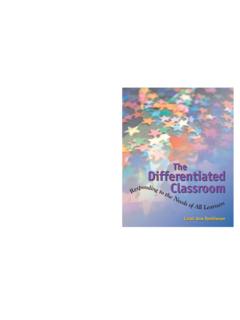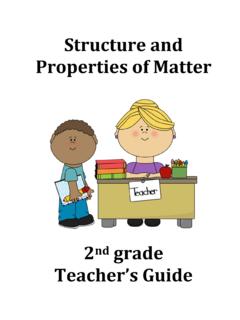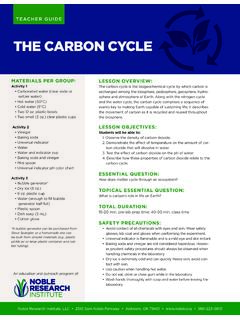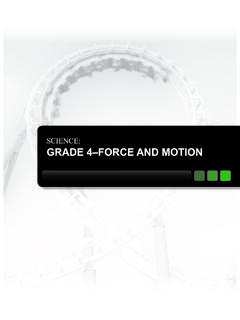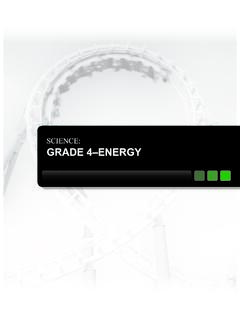Transcription of Structure and Properties of Matters
1 Structure and Properties of Matters 5th Grade Unit teacher Manual NGSS Lesson Planning Template Grade: 5th Topic: Structure and Properties of Matter Lesson 1 Modeling the Particles of Matter Brief Lesson Description: A variety of online simulations, strategies of think pair-share, Edmodo survey polls, model drawings, student labs and writing pieces (summary/evidence based response/acrostic poetry) will help students understand the concept of scientific modeling of matter particles. A scientific model is an abstract, simplified representation of a system. A model should explain data, agree with what we know about the Laws of Nature and can be used to make a prediction. The Crosscutting Concept for this lesson is Natural objects exist from the very small to the immensely large so a focus will be placed on matter in the gaseous state and how it is detected.
2 Activities that require the internet can be viewed on individual student laptops, computer lab, and mobile lab or be done as a whole group lesson using a projection tool. Performance Expectation(s): 5-PS-1 Develop a model to describe that matter is made of particles too small to be seen. Students will develop their own models to describe phenomena. They will build and revise simple models and use them to represent events and design solutions. Students will focus on a model that shows that gases are made from matter particles that are too small to see. Specific Learning Outcomes: Students will be responsible for summarizing their understanding of what a scientific model is and how it can be used. Students will build and revise a model to describe phenomena concerning matter in its particle form with a focus on matter in the gas state.
3 Students will be responsible for design and conducting an investigation dealing with gaseous particles. Narrative / background information Prior Student Knowledge: Plan and conduct an investigation to describe and classify different kinds of materials by their observable Properties .(2-PS1-1) Analyze data obtained from testing different materials to determine which materials have the Properties that are best suited for an intended purpose.(2-PS1-2) Make observations to construct an evidence-based account of how an object made of small set of pieces can be disassembled and made into a new object. (2-PS1-3) Construct an argument with evidence that some changes caused by heating or cooling can be reversed and some cannot. (2-PS1-4) Science & Engineering Practices: Asking questions (science) and defining problems (engineering) Developing and using models Planning and carrying out investigations Analyzing and interpreting data Using mathematics and computational thinking Constructing explanations (science) and designing solutions (engineering) Engaging in argument from evidence Obtaining, evaluating, and communicating information Disciplinary Core Ideas: Matter of any type can be subdivided into particles that are too small to see, but even then the matter still exists and can be detected by other means.
4 A model showing that gases are made from matter particles that are too small to see and are moving freely around in space can explain many observations, including the inflation and shape of a balloon; the effects of air on larger particles or objects. (5-PS1-1) Crosscutting Concepts: Patterns Cause and effect: Mechanism and explanation Scale, proportion, and quantity Systems and system models Energy and matter: Flows, cycles, and conservation Structure and function Stability and change Possible Preconceptions/Misconceptions There is no space between the particles of solids. The size (dimension) of the particles of solids is bigger than the particles of liquids and the particles of liquids are bigger then of gases. The particles of solids cannot move. Solids are made up of the particles completely, but liquids and gases are made up the particles not completely (contain another things).
5 All solids have a definite shape The shape of solids does not change. Although solids have volume liquids and gases do not. Solids have more particles then that of liquids which have more particle than gases. 1 Gases do not have are light, liquids are heavier than gases and solids are the heaviest. Matters that can be poured from one container to the other are liquids. Gases fly. Since gases are not affected by gravity they do not fall down like solids and liquids. Gasses do not have weight Educatonal Research and Review 2011 LESSON PLAN 5-E Model ENGAGE: Opening Activity Access Prior Learning / Stimulate Interest / Generate Questions Share internet website Strange Matter and explain how to navigate site (use the zoom inside section only). Students are to work their way through the site then through a whole class discussion about information from the simulation.
6 Record student responses on chart paper. Scientific Model and Matter need to be defined. (free site) Share internet website Acrostic Poem and explain how to navigate site. Students are to create an acrostic poem about matter. Save and share poetry as time allows. Use ideas and definitions from prior lesson to build poem. (free site) EXPLORE: Lesson Description /Questions Does matter still exist if you cannot see it? In what ways can matter change? Use the McGraw-Hill Interactive to learn about the foundational concepts about particle matter. As a whole group, use the Quiz to review the main ideas. Students are to draw and label a model of the 3 states of matter. (free site) Use this BBC website to look at matter in its different states, follow the simulation steps and take the quiz at the end.
7 (free site) Use the Brain Pop Website to explore the states of matter. They will determine whether an example of matter is a solid, liquid, gas or plasma through collaborative/real world activities and computer simulation. This site has the embedded States of Matter Video, Matter Sorter Game, Group Classroom Lesson and Review Quiz. Also, students will use the Cause and Effect Graphic Organizer as a recording device for the States of Matter (gas state) Experiment. (purchase site) View the Wonderville Clip have students record all the representations the filmmakers used for depicting gases. (free site) EXPLAIN: Concepts Explained and Vocabulary Defined Matter is made of particles too small to be seen. Matter of any type can be subdivided into particles that are too small to see, but even then the matter still exists.
8 Pose the question to students- How could you lift this book above the desk? Supply baggies and books-ask students to make observations as to what is holding up the How could you develop this model (cushion of air) a d engineer it into a useable product? Does a balloon gain weight as you fill it? Have students use two methods (blow-up using their lungs and blow-up using a pump) Weigh each method and record to see if there is a difference in the 2 gases. Have students form explanations based on evidence as to why there is a difference. Vocabulary: Model-Observations-Matter-Particles-Stat es of Matter-Phase Change-Solid-Liquid-Gas teacher demonstration Screaming Balloons, focus on the effect of gas on a balloon (filling it) teacher demonstrates adding air to expand a variety of inflatable objects such as: balloons, basketball, football, beach ball, air mattress, whoopee Use this site for ideas.
9 Students will then design a model (drawing) that uses a gas to create an object to help people in their everyday life. (Help people learn, swim, live, travel, health, building) Possible rubric: 2 Use this BBC Website to look at matter in the gas phase, follow the simulation steps and take the quiz at the end. (free site) EVALUATE: Formative Monitoring (Questioning / Discussion): Student Lab Sheets Student built model examples teacher observations & data records Quick Quizzes Scientific dialogue with students Summative Assessment (Quiz / Project / Report): Work in Elaborate Further / Reflect: Enrichment Activities 3 Materials Required for This Lesson/Activity Quantity Description Potential Supplier (item #) Estimated Price 6 sets Plastic beakers (2 per kit) 6 set Funnels (2 per kit) 12 Stopwatches (4 per kit) 6 sets Dry Measure (2 per kit) 6 sets Flexible Rulers(2 packs per kit) 9 sets Test Tubes with Racks (3 per kit) 2 Dune Balances (1per kit) Do you have another one of these?
10 3 Tape Measures (1 per kit) 3 Floating Magnet Sets (1 per kit) 6 Test Tube (2 per kit) 3 Site Licenses to Brain Pop (Dreaming Instead of textbooks?) ISD Technology Purchase $ per classroom 3 packs of 100 7 oz. solo wax cups (1 set per kit) Gordon Foods 6 packs of 50 2 oz. clear plastic cups (1 pack per kit) Gordon Foods 3 Quart Kits Flexible Foam (1per kit) IASCO $ 30 9 clear latex balloons Party Store 30 11 clear latex balloons Party Store 60 hex nuts Hardware Store 4 NGSS Lesson Planning Template Grade: 5th Topic: Structure and Properties of Matter Lesson 2 Identifying Substances by their Properties Brief Lesson Description: Students will investigate Properties of solid substances. Students will learn about Properties of liquids and solids.
